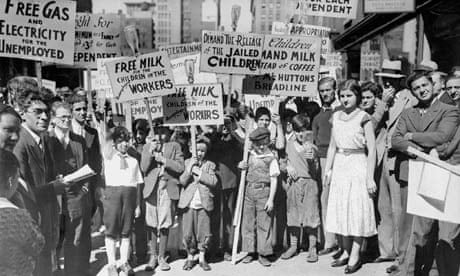New York, Thursday.
Despite extraordinary precautions taken by the police throughout the United States, a number of minor disorders and rioting took place in various parts of the country today. In Washington the police were obliged to use tear gas to disperse a gathering on "Unemployment Day" demonstrators in front of the White House, and several communists were injured in a struggle with the police when the leader of the demonstrators climbed the iron railing of the Presidential grounds and attempted to speak.
President Hoover had previously sent out word to the police not to interfere with the meeting provided there was no disorder and the demonstrators confined themselves to the public thoroughfares. The police considered that the leader of the demonstrators had violated the President's instructions and forced him to get down on the ground.
A boy of eighteen, wearing a flaming red sweater, grasped one of the policemen from behind, and a general mêlée started. Youth and police fell to the pavement together, whereupon another policeman drew his revolver and fired a charge of tear gas at the demonstrators, who fled in all directions. About twenty persons, including several girls, were immediately arrested. Throughout the demonstration President Hoover was working in the office only a hundred yards away.
In New York, a mammoth demonstration was staged in Union Square – the Trafalgar Square of New York. A crowd estimated at more than 75,000 was present. The square was jammed to overflowing, and traffic had to be diverted. The roof tops and windows were lined with curious onlookers. More than one hundred detectives moved among the crowd.
Considerable resentment was caused in newspaper quarters when it was discovered that [Police Commissioner] Mr Whalen had disguised a number of his detectives as reporters, even equipping them with special press badges. Two bags full of tear-gas were held in readiness. Scores of speakers addressed the crowd from various rostra and the audience joined lustily in singing the "Internationale."
Later, however, when the demonstrators wanted to form a procession to march to the City Hall they found the way barred by Mr Whalen and his men and the trouble began. The Police Commissioner first attempted to parley, and offered to take the leaders in his car to City Hall to see the Mayor, Mr "Jimmie" Walker, but the offer was refused and the Reds attempted to rush Mr Whalen and his bodyguard. A "riot call" was at once sent out, and militia, fire brigades and riot squads appeared as if by magic.
The police rallied and charged the demonstrators, eventually succeeding in dispersing the meeting. Several policemen as well as a number of Communists were injured. The ringleaders were arrested on a charge of inciting to riot.
[International Unemployment Day – or "Red Thursday" as the Manchester Guardian called it at the time – was an international day of protest against the mass unemployment of the day, organised by the Communist International and held on 6 March 1930. Demonstrations were held in London, Manchester and other European cities, as well as the events in the US detailed above.]

Comments (…)
Sign in or create your Guardian account to join the discussion